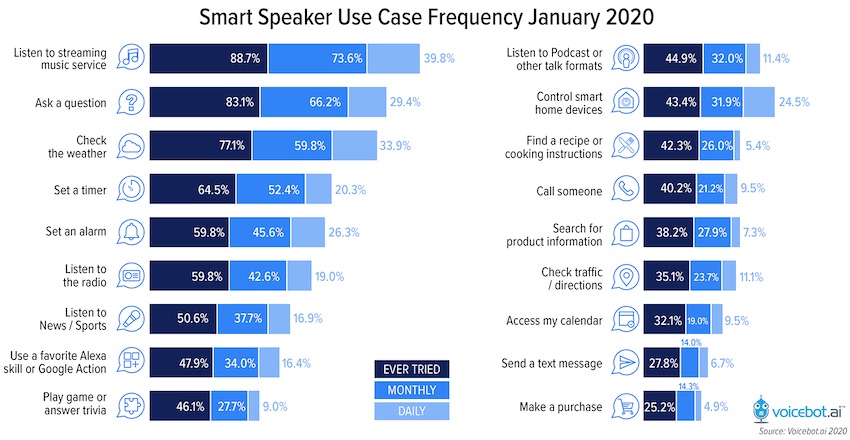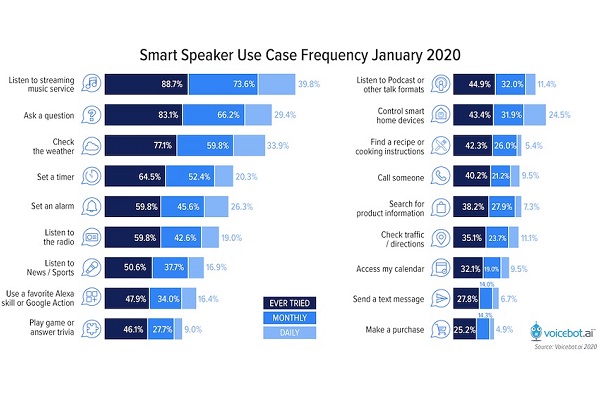Streaming Music, Questions, Weather, Timers and Alarms Remain Smart Speaker Killer Apps, Third-Party Voice App Usage Not Growing
Consumers are remarkably consistent with their smart speaker usage. A survey from this year of over 1,000 U.S. adults found that playing streaming music was the most common smart speaker use case device owners had “ever tried” as well as leading for monthly and daily active use. “Ask a question” came in second for “ever tried” and monthly active usage but trailed third place “check the weather” for daily use. Timers and alarms held down the fifth and sixth slots. These were also the same top five smart speaker use cases in January 2018 and 2019.

You can learn what types of questions consumers ask most often as well as go much deeper in a number of areas in Voicebot’s Smart Speaker Consumer Adoption Report 2020. It includes over 30 charts and 30 pages of analysis. There is also an executive summary containing 10 charts and 15 pages of discussion. Learn more below.
DownloadAudio Entertainment Up, Questions and Weather Down
Despite continued strong usage for questions and weather it is notable that both are down from previous years. Daily use of asking questions to smart speakers declined 7.6% between January 2019 and 2020. Since voice search is rising, this may suggest that consumers are not getting the quality they want when asking questions of their smart speakers. This may be because they are returning to a model where a voice response will return a list of blue links or because voice assistants are increasingly defaulting to simplistic responses from sites such as Wikipedia and Yelp! which Voicebot researchers first revealed in the 2019 Voice Assistant SEO Report for Brands.
Weather was also down in overall use for the second straight year. This might indicate some softness in these categories that have strong alternatives on mobile and web.
Audio entertainment is seeing a different trend. Listening to the radio on smart speakers is up about 4% for “ever tried” and 2% for “monthly active users,” although it did show a 2% decline for daily active users from 2019. Using smart speakers for news and sports information was up across the boards rising 7% for “ever tried,” 9% for monthly active, and about 3.5% for daily active users. Podcasting rose about 5% for both “ever tried” and monthly active users.
Third-Party Voice Apps Flat to Down Slightly
For non-audio entertainment and news voice apps (i.e. Alexa skills, Google Actions, et al.) developed by third-parties (i.e. not Alexa, Google, etc), usage is slightly down or flat across the board. These are the voice apps made by the ecosystem partners of Amazon and Google. Essentially they are in line with 2019 and 2018 but show a slight decline. This cannot be heartening for those developers that have been committed to the platforms and have struggled to drive discovery and trial for their voice apps.
Only 48% of smart speaker owners say they have used third-party voice apps. Granted, consumers may be using third-party voice apps related to audio entertainment, but that is a technicality to them. They are thinking about voice-first experiences purpose-built for smart speakers as opposed to repurposing audio content already available through other channels.
Despite the lack of growth in the percentage of use for third-party voice apps, there are two slivers of good news in the data for developers. First, the market grew significantly. So, maintaining share of trial translates into more overall users simply because the audience is expanding. The data also show that smart speaker owners that try third-party voice apps are trying more of them and using more on a monthly active basis. There are seven charts and in-depth analysis of third-party voice app adoption trends in the full Smart Speaker Consumer Adoption Report.
Follow @bretkinsella Follow @voicebotai
Introducing Voicebot Research – The Most Comprehensive Data on Voice Assistants and AI
Yes. The Bedroom is Now the Most Popular Location for Smart Speakers. Here’s Why and What it Means.









